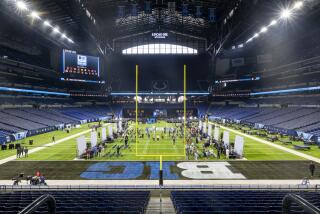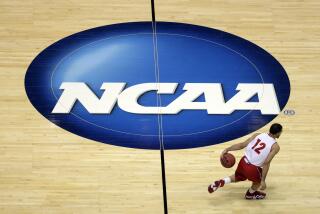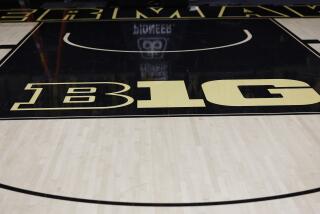COLLEGE BASKETBALL : NCAA Reforms in Place for Tournament
- Share via
KANSAS CITY, Mo. — Maybe it will turn out to be just 63 also-rans fighting for the right to get routed by top-ranked, defending champion UNLV.
Or maybe history will repeat itself to the tune of 1983, the year an unranked North Carolina State ambushed Akeem Olajuwon and Houston’s supposedly unbeatable Phi Slamma Jama.
But one thing about the 64-team NCAA Tournament being unveiled at 3:30 p.m. Sunday is clearer, and in the minds of many reform-minded insiders, of more lasting note.
“As much as possible,” says NCAA executive director Dick Schultz, “we’ve got them playing for the trophy.”
With this tournament begins the NCAA’s grand plan for taking money, supposedly the cause of so many college ills, and turning it into an instrument of reform. Now is when the NCAA attempts to double the tournament television revenue to $1 billion while reducing at the same time the financial pressure to win.
Will it have any noticeable effect on how the games are coached or played over the next three weekends leading up to the Indianapolis Final Four? Definitely not, say the people who spent more than a year orchestrating the plan and selling it to the basketball powers.
Still, Schultz spoke often of eliminating “the $200,000 free throw.” And it’s going to be a radical departure when athletic directors shake those NCAA checks out of the mail next month that are no longer based solely on how many tournament games their school or conference has just won.
Instead, tournament victories will be only one factor in a complex equation that attempts to take the money and turn it, as much as possible, into an instrument of reform.
The formula is so complicated, the NCAA has staffers working on a separate explanation sheet for media covering the tournament. Essentially, it divides the seven-year $1 billion CBS contract into two roughly equal pools, with one dispersed on the basis of such things as commitment to broad-based athletic programs, number of scholarships given, etc.
The “participation pool,” is based on a rollover period that counts only the number of tournament games a school’s conference played -- not won -- the previous six-year cycle. Each game is counted as one unit except the title game, which is not counted at all.
The unit value this year is estimated around $42,000. And thus in an ironic fiscal twist, getting to the Final Four will produce less revenue -- about $210,000 -- than the $294,000 schools got last year for just showing up. It will be about five times less than the $1 million that went to last year’s Final Four teams.
Once the final accounting is done, most schools will wind up with more tournament money than ever before because the contract’s value more than doubled. But they will earn a smaller percentage by winning tournament games.
“One way to think of it is that last year, a unit was worth $294,000 and this year a unit is going to be worth about $42,000,” said Lou Spry, an associate executive director of the NCAA.
Although proponents of the plan used to talk about doing away with the financial pressure cooker many coaches work under, those closest to the process now insist there will be no impact on the competition itself.
“Guys are still going to be stressed out. Fans are still going to be exhilarated by the wins and deflated by the losses,” said Jim Delany, who served on the revenue distribution committee and chairs the tournament selection committee.
As a reserve guard for North Carolina in the 1960s, Delany played in the Final Four.
“It’s not going to change the way the athletes play,” he said. “That sort of thing has always been the furthest thing from the athletes’ minds. I don’t expect it to change the tournament in any way, other than to say we’ve dulled the financial importance of winning by distributing the money in other ways and spreading out the impact over six years while dividing the money among the conferences rather than sending it to the institutions.”
While the new plan may not change the way a coach attacks a full-court press, it could help the battered image of college athletics, said NCAA president Judy Sweet.
“I think there’s a public perception that men’s basketball and football are questionable as amateur athletic events,” said Sweet, who chaired the revenue distribution committee. “By removing the direct assignment of dollars to the teams’ performance in the tournament, we are moving in the direction of rightfully restoring intercollegiate athletics as an amateur athletics entity.”
CBS again planned live coverage of the announcement of the tournament bracket, the product of marathon meetings in Kansas City which the nine-man selection committee began Friday morning. Thirty of the 64 berths go automatically to conference champions or conference tournament champions, leaving a pool of 34 at-large bids. This year’s field will be diluted in one sense because three tournament-caliber teams are ineligible by probation -- Illinois, Kentucky and Missouri.
Giving the tournament another unique twist is the very presence of the swaggering, heavily favored Runnin’ Rebels of Las Vegas. The program whose long, heavily publicized battles against the NCAA have practically become a second career for coach Jerry Tarkanian is in the tournament only by grace of an unprecedented reversal by the infractions committee.
Trying to put an end to a case that had dragged on since 1977 and even reached the U.S. Supreme Court, the committee ruled last summer that UNLV would be barred from defending its championship this spring. With four returning starters and a rare shot at consecutive championships, the school and its fans were livid.
UNLV was granted a second appearance before the committee, an unusual occurrence in itself. The committee, possibly fearing that UNLV players would get a temporary restraining order in the Nevada courts forcing the NCAA to let their team in anyway, reversed itself in September and gave the school two alternative penalties to choose from. The Rebels snapped up the option of a television and tournament ban next year.
Many schools were upset at this apparent cave-in, and Schultz has personally made a fence-mending trip to Kansas, which was barred from defending its 1988 title without getting a chance to choose its own penalty.
NCAA officials say publicly they believe the committee did the right thing, pointing out that legal technicalities and the extraordinary length of the UNLV case made it unique.
But many observers believe a dangerous precedent was set that will come back to haunt the infractions committee the first time a school demands alternative penalties of its own.
“Wouldn’t it be ironic,” said one conference official, “if Jerry Tarkanian, while winning back-to-back NCAA championships, has also managed to plant a ticking time bomb plant in the enemy camp?”
More to Read
Go beyond the scoreboard
Get the latest on L.A.'s teams in the daily Sports Report newsletter.
You may occasionally receive promotional content from the Los Angeles Times.










